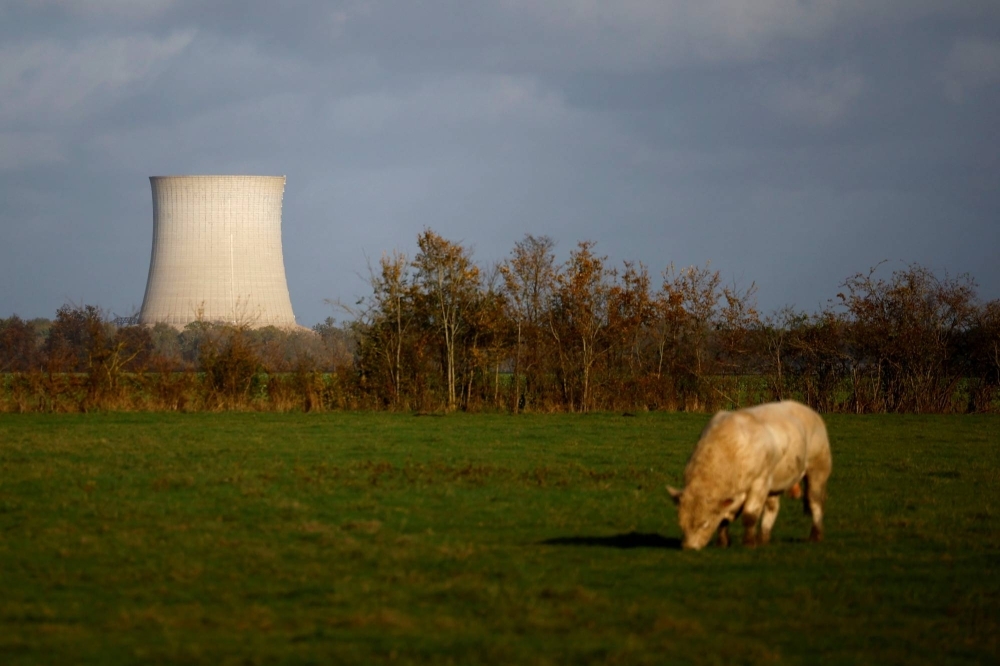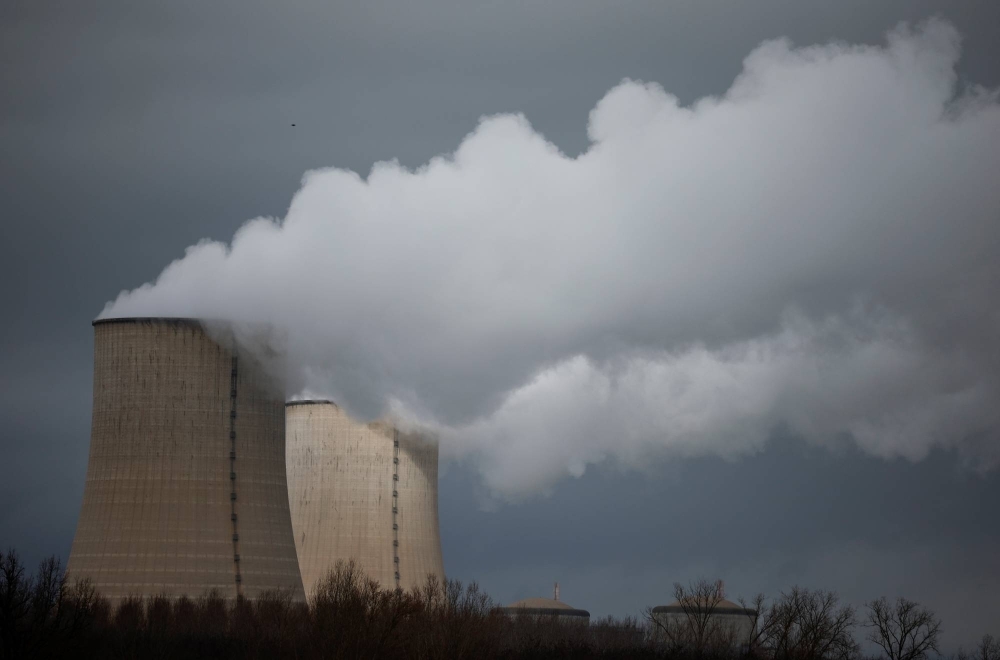One of the last holdouts, Australia weighs nuclear power pivot

The cooling towers of the Saint-Laurent-Des-Eaux nuclear power plant site near Orleans, France, in 2023. Long a nuclear-power holdout, Australia is now debating a switch that could see the country end its decadeslong resistance to the energy source. | REUTERS
BY BEN WESTCOTT
BLOOMBERG
Jul 11, 2024
Australia, one of the world’s last major nuclear power holdouts, is debating a pivot that could see the country end its decadeslong resistance to the energy source.
With less than a year until Australia heads to the polls, the Liberal National Coalition parties are making nuclear power a central plank of their policy platform to oust the current Labor government, driven in part by their historic opposition to renewables and by recent polling that shows more Australians are open to nuclear energy than ever before.
If they win the election due to be held by May next year, the coalition pledges to build nuclear reactors in seven locations in Australia by 2050.
"Only with a balanced mix of technologies, including renewables, zero-emissions nuclear and gas will Australia have any hope of reaching net zero by 2050, while remaining an economically prosperous economy,” the coalition's energy spokesman Ted O’Brien said in an interview.
There’s a long way to go, even if the coalition pulls off a win.
While Australia is one of the world’s top sources of uranium, energy experts say there’s a reason why Australia has never embraced nuclear energy. Beyond the historic hangups stemming from the testing of atomic weapons in the region, any new policy would need to overturn laws that currently ban the use of nuclear power, overcome local resistance and factor in the formidable costs of building new reactors, all while creating a whole new domestic nuclear industry to build, operate and support the reactors.
But Australia’s potential turn to nuclear power is in line with a global trend, with climate change and increasing geopolitical frictions forcing a global rethink about energy security and efforts to reduce emissions.
South Korea has recently reversed course, Japan is pushing to restart idled reactors, the United States is experimenting with smaller reactors and China is looking at adding as many as 10 reactors a year.
This has left Australia as part of a shrinking group of developed economies who don’t use, have never used and have no current plans to develop nuclear power.
The coalition’s proposal comes at a time when the share of renewables as part of the country’s energy mix has doubled from about 16% in 2016 to more than 32% in 2022. With abundant land and readily available renewable resources, experts question the cost of deploying nuclear reactors, with many current projects worldwide running into delays and plagued by cost overruns.
According to 2024 research from Australia’s leading research body CSIRO, nuclear was the most expensive energy option available at present.
"It will not be possible to have nuclear at least by 2040,” said Dr Asma Aziz, a senior lecturer in power engineering from the School of Engineering at Edith Cowan University. "We don’t have clarity on the cost, safety is an issue and I don’t know how many people would want to live near a nuclear plant.”
Opposition Liberal Party leader Peter Dutton claims they could have the first reactors up and running within 10 years. But a report prepared during a conservative government in 2006 estimated that it would likely take 15 years to build a viable nuclear power plant in Australia.
The incumbent Labor government points to these factors when highlighting its opposition to the coalition’s proposals. Energy Minister Chris Bowen said that the coalition’s nuclear plans would provide "at best 4% of Australia’s energy needs.”
"Nuclear energy is too slow to keep the lights on, too expensive to be economic and deliver affordable energy, and too risky for Australia’s energy needs,” Bowen said in a statement.
Testing times
Australia has a long and fraught history with nuclear power. Starting in the mid-20th century, nuclear weapons testing left a bitter taste in many Australians’ mouths and sparked a protest movement that endures to this day.
The United Kingdom conducted 12 major nuclear weapons tests across three sites in Australia in the 1950s, often without informing citizens of the risks and without the permission of the Indigenous communities on whose land they were testing.
This was followed by nuclear tests by the French government in the Pacific starting in 1966, far closer to Sydney than they were to Paris.

Australia is part of a shrinking group of developed economies who don’t use, have never used and have no current plans to develop nuclear power. | REUTERS
The tests created a fierce anti-nuclear movement across the country, which long campaigned for a ban on uranium mining altogether. Attempts to build a nuclear reactor in Jervis Bay on Australia’s eastern coastline were met with fierce protests and eventually abandoned.
In 1998, then center-right Liberal Party Prime Minister John Howard banned the development of nuclear power in Australia as part of a deal with the pro-environment Greens Party. The ban remains in place.
As recently as 2011, 62% of Australians said they were opposed to nuclear power, compared to just 35% in favor, according to a Lowy Institute survey.
However there is some indication that Australians’ attitudes to nuclear power might be evolving. A poll by Essential Research in April 2024 found more than 50% of Australians were supportive of Australia developing a nuclear industry.
Nuclear option
Eyeing that shift, the Liberals are planning to head to the next election with lifting the ban on nuclear power as a major part of their platform.
So far, Liberal leader Dutton has only released broad details of his plan. Seven nuclear power plants would be built in Australia over the next 2½ decades, with the reactors to be located at sites of decommissioned coal generators. Dutton said the first two plants could be operating by 2035.
The nuclear plants themselves would be state-owned, funded with public money rather than through the private sector. However, details such as the final cost of the policy, the planned energy mix and how future governments would bridge the transition to nuclear power are unclear.
"We are at a fork in the road in Australia and the path we venture down in pursuit of net zero will determine the sort of country we are mid-century,” O’Brien said in an interview.
Supporters of the coalition’s policy point to the shift by other large economies to re-embrace nuclear as a reliable and tested source of energy to take Australia to its net zero targets by 2050.
Brandon Munro, executive chairman of uranium development company Bannerman Energy, said he believes that nuclear power would be "absolutely essential for Australia’s long-term competitiveness and prosperity.”
"I think it’s naive to contemplate deep decarbonization of industrial processes without such an important tool, particularly when most other industrial countries are moving stridently toward an increased use of nuclear power,” he said.
Climate wars
But not everyone agrees, and some have accused the coalition of picking nuclear as just the latest salvo in Australia’s decadeslong political feud over climate change, a final push by the center-right parties to avoid giving in to a renewables-led future.
Australia is one of the world’s largest per capita greenhouse gas emitters and also one of the biggest exporters of coal and gas. As a result, the country has seen savage political contests over the past two decades on how to tackle rising emissions, which have led to the toppling of governments and the unseating of prime ministers.
"The coalition have allowed their ideological opposition to wind and solar to get in the way of smart policymaking and investment in Australia,” Energy Minister Bowen said, adding that Australia needed more energy capacity now and not in over a decade’s time.
Many had hoped the debate had finally been decided after the May 2022 election. Climate change was a decisive issue at the vote, seeing a swathe of pro-green energy independent lawmakers elected and the coalition, which had long been accused of dragging its feet on the renewable transition, kicked out of power.
After entering office, new Labor Prime Minister Anthony Albanese implemented the country’s first emission targets and attempted to ramp up the transition to renewable energy. However, investment has yet to pick up and the coalition has ramped up its attacks on the energy transition.
Critics point to the lack of detail from the opposition about how Australia would bridge any gap between aging coal power and a potential nuclear future without major investment in an alternative power source such as renewables.
Ian Lowe, energy expert and emeritus professor at Griffith University in Queensland, said the policy could have been an attempt by parts of the Liberal Party to extend coal and put off a switch to renewables even further.
"It’s an act of desperation to appease those in the coalition ranks who don’t accept the science of climate change,” he said.
No comments:
Post a Comment